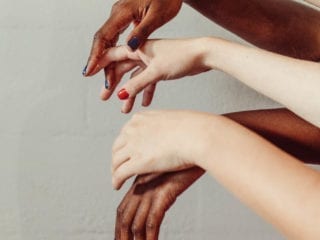This post is a part of a series called “Help Me Understand,” where we practice the art of dialogue about important issues. The focus is to come around the table and learn to have healthy conversations with people of diverse backgrounds in order to learn.
Women’s rights activist Gloria Steinem recently sat down with the Duchess of Sussex in a quaint backyard interview to discuss voting rights.
“If you don’t vote, you don’t exist. It’s the only place where we are all equal: in the voting booth. We not only have to vote, but we have to fight to vote,” said Steinem.
“We not only have to vote, but we have to fight to vote.” — Gloria Steinem
In the United States, the right to vote has never been a given. Yet, in the words of U.S. Representative John Lewis, “The vote is the most powerful nonviolent tool we have.” Voting is both a tool and a hard-won responsibility.
The Electorate in Early America
In early America, the electorate was small and homogenous, composed nearly entirely of voters who were white, male, Protestant and landowners over the age of 21. The U.S. Constitution did not grant voting rights to Native Americans, women or enslaved people.
The Constitution also included the “three-fifths clause,” which reduced an enslaved person to 60 percent of the personhood or value of a free person. This strengthened the voting power of the South by including enslaved individuals in the state population without actually allowing them to vote.
Voting Post-Civil War
In 1865, the 13th Amendment ended slavery. In 1868, the 14th Amendment granted citizenship rights to everyone “born or naturalized” in America. In 1870, the 15th Amendment banned discrimination against and the disenfranchisement of voters based on “race, color or previous condition of servitude.”
The Black Codes and Jim Crow laws, however, legalized racial segregation in the South. The South’s separate-but-equal agenda denied Black Americans voting rights through voter suppression and white supremacist mob terror. Overly complicated voter registration, poll taxes, literacy and constitution tests, “white-only” primary elections and grandfather clauses blocked Black citizens from registering to vote and exercising their civil rights.
Women’s Suffrage
In 1848, activists and intellectuals, including Elizabeth Cady Stanton, Lucretia Mott and Frederick Douglass convened in Seneca Falls, New York to create and sign the “Declaration of Sentiments,” an indictment of the oppression of women in America, initiating the women’s suffrage movement.
Throughout the suffrage movement, hundreds of women voted illegally in protest, marched and engaged in civil disobedience. In 1890, advocates, like Stanton and Susan B. Anthony, banded together to form the National American Woman Suffrage Association. However, the formation of this organization represented a larger split between white women and women of color.
Some white suffragists employed white supremacist arguments to make women’s suffrage more palatable to the white patriarchy. In response to this, in 1896, Harriet Tubman, Ida B. Wells, Frances E.W. Harper and Mary Church Terrell formed the National Association of Colored Women to better advocate for civil rights, gender equality and racial justice.
In 1920, the 19th Amendment made voter disenfranchisement on the basis of sex unconstitutional, but this did not secure voting rights for all women. Racist legislation, ongoing voter suppression and violence denied women of color voting rights for decades to come.
The Civil Rights Movement
Martin Luther King, Jr. argued in 1957, “The denial of this sacred right is a tragic betrayal of the highest mandates of our democratic tradition…our most urgent request to the president of the United States and every member of Congress is to give us the right to vote.”
In 1964, Malcom X said, “It’s the ballot or the bullet.”
In 1964, in Selma, AL, for example, only 2 percent of Black people were registered to vote. The Southern Christian Leadership Council and the Student Nonviolent Coordinating Committee organized extensively to register Black citizens to vote against the forceful tide of white supremacist intimidation and violence.
Motivated by national outrage following the brutal treatment of demonstrators on “Bloody Sunday,” President Lyndon B. Johnson signed the Voting Rights Act of 1965.
Voter Suppression
In 2013, the Supreme Court invalidated a key component of the Voting Rights Act by giving states permission to regulate elections (moving polling locations, instituting Voter ID laws or changing boundaries of electoral districts) without approval from the Justice Department or federal courts. In the 5-4 decision, the justices were split over whether or not racial discrimination still affects voting rights today.
This decision allowed voter suppression efforts in many states to snowball, leading to an increase in Voter ID laws, higher numbers of (highly inaccurate) voter purges and an increase in gerrymandering. Voter suppression continues to undermine the integrity of our elections, disenfranchising millions of voters.
By tracing the lineage of voting rights in the U.S., it is clear that Steinem’s assessment is correct. Voting is a fight, an ongoing struggle, for justice, as much as it is a right and an aspiration.
Voting is a fight, an ongoing struggle, for justice, as much as it is a right and an aspiration.
In his posthumous essay, John Lewis wrote, “Democracy is not a state. It is an act, and each generation must do its part to help build what we called the Beloved Community, a nation and world society at peace with itself.”
This November, let us use our vote—this nonviolent tool—well. Let us also remember our nation’s fundamental motto: E pluribus unum—out of many, one.
Why is it important to understand the history and structure of the American voting system? How can this awareness help us in the current election cycle?
Image via Ashley Wingo, Darling Issue No. 17











